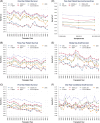Performance of risk prediction models for post-liver transplant patient and graft survival over time
- PMID: 38265295
- PMCID: PMC11175754
- DOI: 10.1097/LVT.0000000000000326
Performance of risk prediction models for post-liver transplant patient and graft survival over time
Abstract
Given liver transplantation organ scarcity, selection of recipients and donors to maximize post-transplant benefit is paramount. Several scores predict post-transplant outcomes by isolating elements of donor and recipient risk, including the donor risk index, Balance of Risk, pre-allocation score to predict survival outcomes following liver transplantation/survival outcomes following liver transplantation (SOFT), improved donor-to-recipient allocation score for deceased donors only/improved donor-to-recipient allocation score for both deceased and living donors (ID2EAL-D/-DR), and survival benefit (SB) models. No studies have examined the performance of these models over time, which is critical in an ever-evolving transplant landscape. This was a retrospective cohort study of liver transplantation events in the UNOS database from 2002 to 2021. We used Cox regression to evaluate model discrimination (Harrell's C) and calibration (testing of calibration curves) for post-transplant patient and graft survival at specified post-transplant timepoints. Sub-analyses were performed in the modern transplant era (post-2014) and for key donor-recipient characteristics. A total of 112,357 transplants were included. The SB and SOFT scores had the highest discrimination for short-term patient and graft survival, including in the modern transplant era, where only the SB model had good discrimination (C ≥ 0.60) for all patient and graft outcome timepoints. However, these models had evidence of poor calibration at 3- and 5-year patient survival timepoints. The ID2EAL-DR score had lower discrimination but adequate calibration at all patient survival timepoints. In stratified analyses, SB and SOFT scores performed better in younger (< 40 y) and higher Model for End-Stage Liver Disease (≥ 25) patients. All prediction scores had declining discrimination over time, and scores relying on donor factors alone had poor performance. Although the SB and SOFT scores had the best overall performance, all models demonstrated declining performance over time. This underscores the importance of periodically updating and/or developing new prediction models to reflect the evolving transplant field. Scores relying on donor factors alone do not meaningfully inform post-transplant risk.
Copyright © 2024 The Author(s). Published by Wolters Kluwer Health, Inc.
Conflict of interest statement
Nadim Mahmud received grants from Grifols. The remaining authors have no conflicts to report.
Figures


Similar articles
-
Comparison of Two Modern Survival Prediction Tools, SORG-MLA and METSSS, in Patients With Symptomatic Long-bone Metastases Who Underwent Local Treatment With Surgery Followed by Radiotherapy and With Radiotherapy Alone.Clin Orthop Relat Res. 2024 Dec 1;482(12):2193-2208. doi: 10.1097/CORR.0000000000003185. Epub 2024 Jul 23. Clin Orthop Relat Res. 2024. PMID: 39051924
-
Normothermic and hypothermic machine perfusion preservation versus static cold storage for deceased donor kidney transplantation.Cochrane Database Syst Rev. 2024 Jul 9;7(7):CD011671. doi: 10.1002/14651858.CD011671.pub3. Cochrane Database Syst Rev. 2024. PMID: 38979743 Free PMC article.
-
Sex and gender as predictors for allograft and patient-relevant outcomes after kidney transplantation.Cochrane Database Syst Rev. 2024 Dec 19;12(12):CD014966. doi: 10.1002/14651858.CD014966.pub2. Cochrane Database Syst Rev. 2024. PMID: 39698949
-
Development of a model to predict the risk of early graft failure after adult-to-adult living donor liver transplantation: An ELTR study.Liver Transpl. 2024 Aug 1;30(8):835-847. doi: 10.1097/LVT.0000000000000312. Epub 2023 Dec 12. Liver Transpl. 2024. PMID: 38079264
-
Clinical outcomes of kidney transplantation from expanded-criteria donors and KDPI>85% kidneys in deceased Chinese donors.BMC Nephrol. 2025 Jul 11;26(1):377. doi: 10.1186/s12882-025-04307-9. BMC Nephrol. 2025. PMID: 40646454 Free PMC article.
References
-
- Kwong AJ, Ebel NH, Kim WR, Lake JR, Smith JM, Schladt DP, et al. OPTN/SRTR 2021 Annual Data Report: Liver. Am J Transplant. 2023;23:S178–S263. - PubMed
-
- Feng S, Goodrich NP, Bragg-Gresham JL, Dykstra DM, Punch JD, DebRoy MA, et al. Characteristics associated with liver graft failure: The concept of a donor risk index. Am J Transplant. 2006;6:783–90. - PubMed
-
- Dutkowski P, Oberkofler CE, Slankamenac K, Puhan MA, Schadde E, Müllhaupt B, et al. Are there better guidelines for allocation in liver transplantation? A novel score targeting justice and utility in the model for end-stage liver disease era. Ann Surg. 2011;254:745–53. - PubMed
-
- Rana A, Hardy MA, Halazun KJ, Woodland DC, Ratner LE, Samstein B, et al. Survival outcomes following liver transplantation (SOFT) score: a novel method to predict patient survival following liver transplantation. Am J Transplant. 2008;8:2537–46. - PubMed
-
- Asrani SK, Saracino G, Wall A, Trotter JF, Testa G, Hernaez R, et al. Assessment of donor quality and risk of graft failure after liver transplantation: The ID(2) EAL score. Am J Transplant. 2022;22:2921–2930. - PubMed
MeSH terms
Grants and funding
LinkOut - more resources
Full Text Sources
Medical

